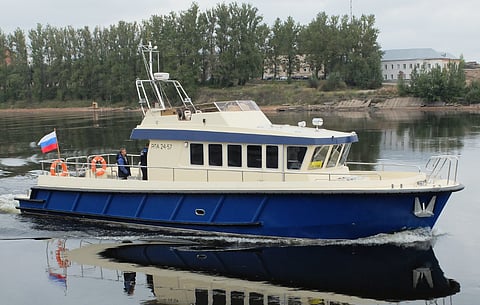

The Border Service of the Federal Security Service of Russia (FSB) has taken delivery of a new patrol boat that is also slated for secondary duties such as search and rescue (SAR) and transport of cargo and personnel. Designed by Russian naval architects Ricochet and built by the Sredne-Nesvky Shipbuilding Plant of state-owned United Shipbuilding Corporation (USC), the new vessel is the fourth Project P1650 patrol boat to be delivered to the FSB's border service.
The new vessel features a steel hull for improved durability and FRP and composites for the deck and the superstructure to guarantee a lower overall weight as well as ease of operation and maintenance – attributes that are important in light of heavy use even during the winter months. The reduced weight aids in limiting the draught, thereby making the boat more capable of navigating through thin surface ice on days of mild winter. The lightweight yet durable construction also means the vessel can operate equally well in inland waterways as well as off the Russian coast where the sailing conditions are typically more challenging.
The new FSB patrol boat has an LOA of 16.5 metres, a beam of 4.35 metres, a maximum draught of 1.4 metres, a displacement of 28.5 tonnes, and space for up to 10 passengers in addition to two crewmembers. Two Cursor 500 ENT M50 main diesel engines that each produce 368 kW drive fixed-pitch propellers to enable the boat to sail at speeds of up to 19 knots in open water, though a cruising speed range of 10 to 13 knots will allow it to cover up to 300 nautical miles in between refuelings. The lower cruising speeds will also be the norm for patrols and inspections in near-shore and inland waters.
When laden with fresh water and provisions adequate for only two crewmembers, the vessel can stay out at sea for 15 days. If 10 additional personnel are embarked, the maximum quantity of provisions that the vessel can carry will be reduced though it can still operate off the coast for a maximum of five days before resupply becomes necessary.
The vessel's aft deck features a large open space for accommodating a wide variety of cargo as well as a swim/dive platform that provides direct access to and from the water. Bollards are also found on the aft deck for use in towing small vessels and pontoons of up to 80 tonnes displacement.
Wide walkways and handrails line the perimeter on either side of the single-deck wheelhouse while a transfer point at the bow is available to facilitate movements to and from jetties and even other vessels, such as during boardings being conducted at sea. A flying bridge has been incorporated as well.
| 16.5-metre Border Guard Patrol Boat | |
| SPECIFICATIONS | |
| Type of vessel: | Patrol boat |
| Flag: | Russia |
| Owner: | Federal Security Service of Russia |
| Operator: | FSB Border Service, Russia |
| Designer: | Ricochet, Russia |
| Builder: | Sredne-Nevsky Shipbuilding Plant, Russia |
| Hull construction material: | Steel |
| Superstructure construction material: | FRP/composite |
| Deck construction material: | FRP/composite |
| Length overall: | 16.5 metres |
| Beam: | 4.35 metres |
| Draught: | 1.4 metres |
| Displacement: | 28.5 tonnes |
| Main engines: | 2 x Cursor 500 ENT M50, each 368 kW |
| Propulsion: | 2 x fixed-pitch propellers |
| Maximum speed: | 19 knots |
| Cruising speed: | 13 knots |
| Range: | 300 nautical miles |
| Other deck equipment: | Bollards |
| Other equipment installed: | Aft swim/dive platform |
| Interior fitout/furnishings: | Stores compartment |
| Safety equipment: | Handrails |
| Type of fuel: | Diesel |
| Crew: | 2 |
| Passengers: | 10 |
